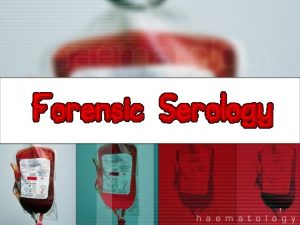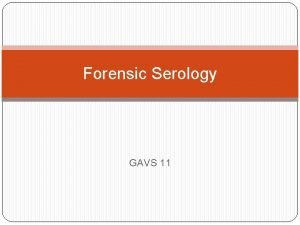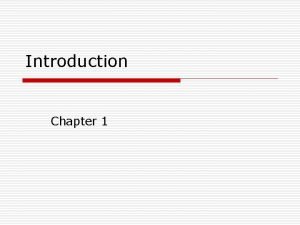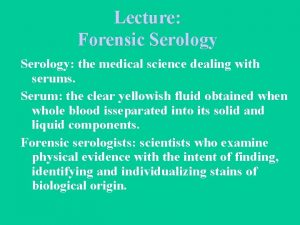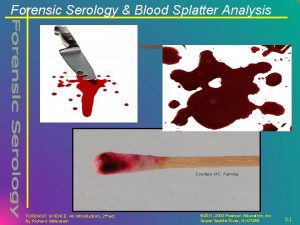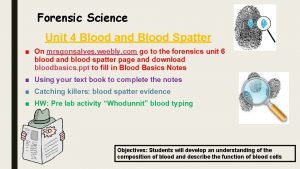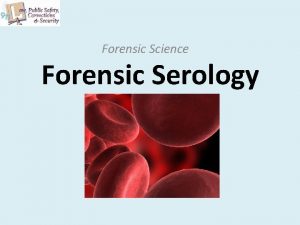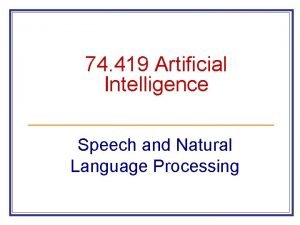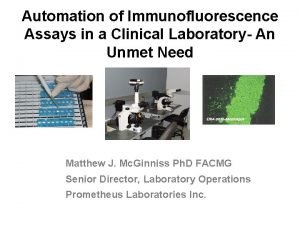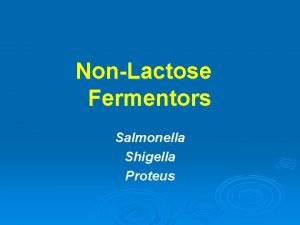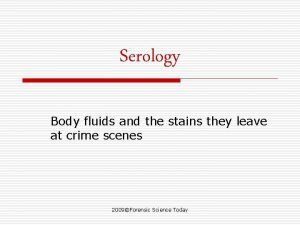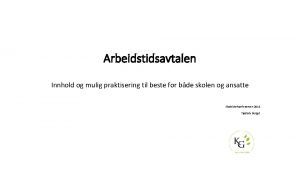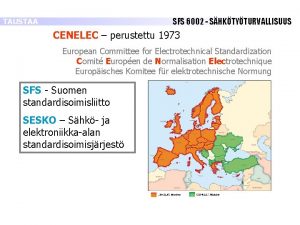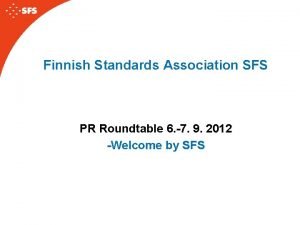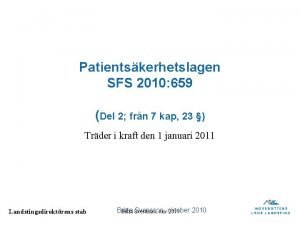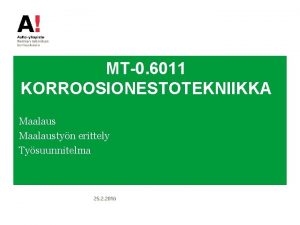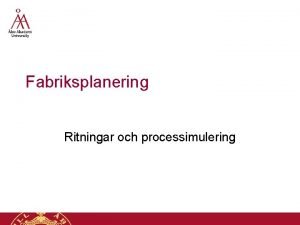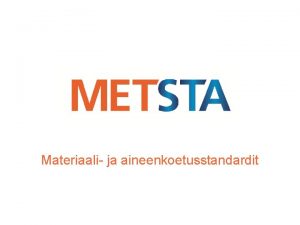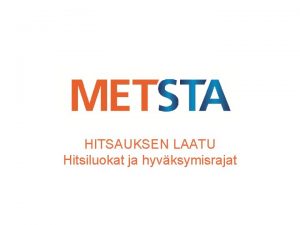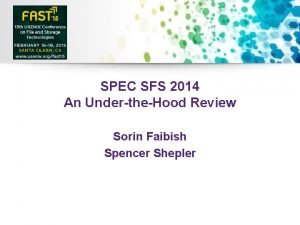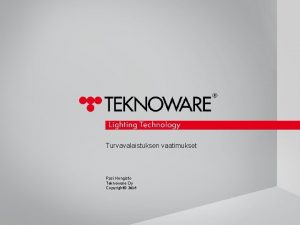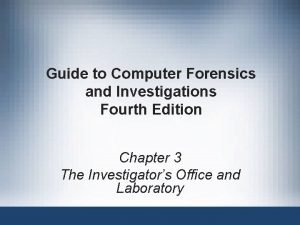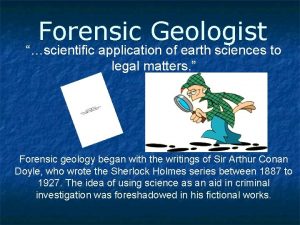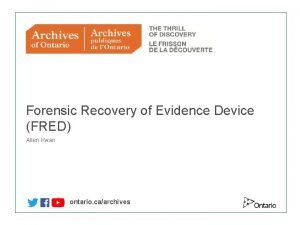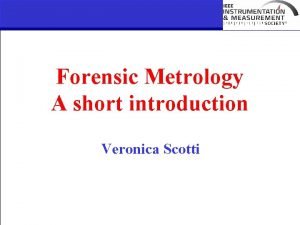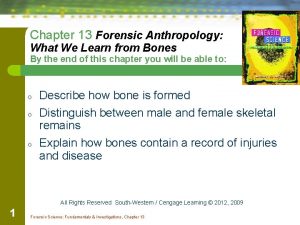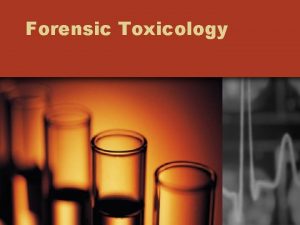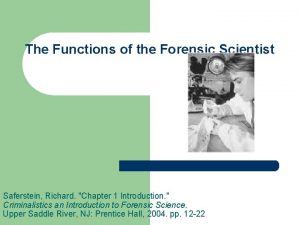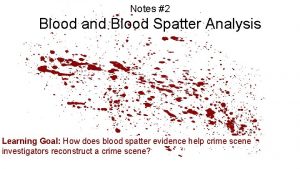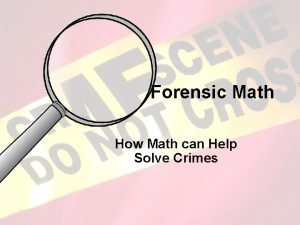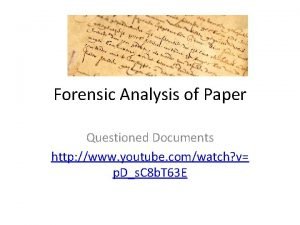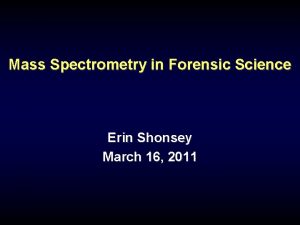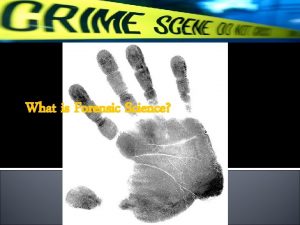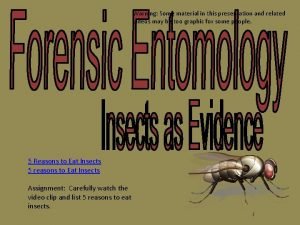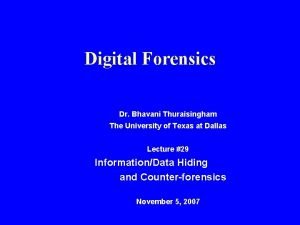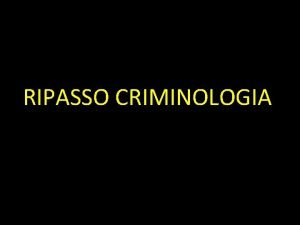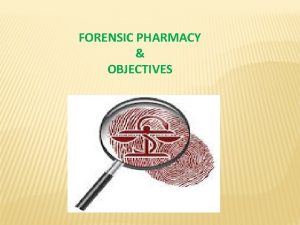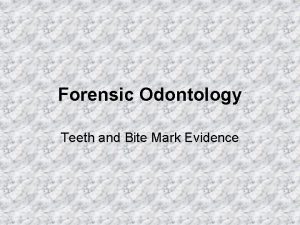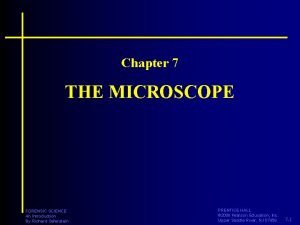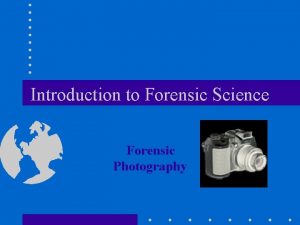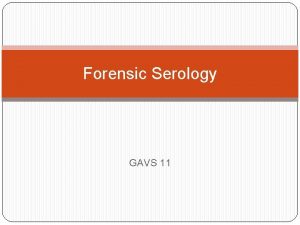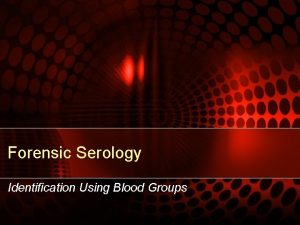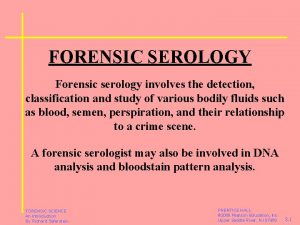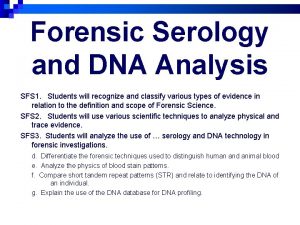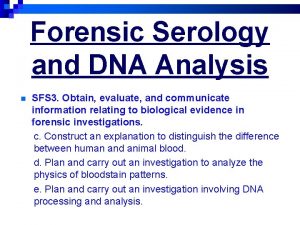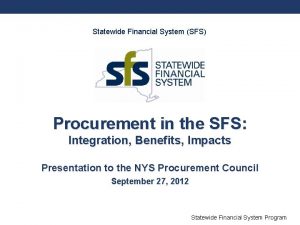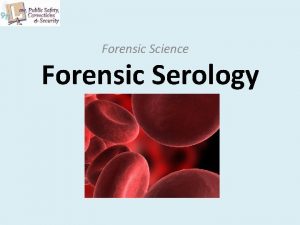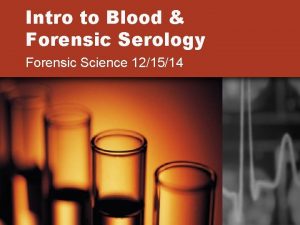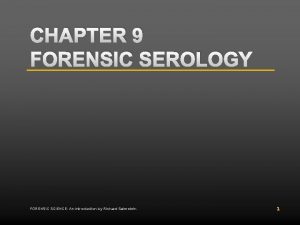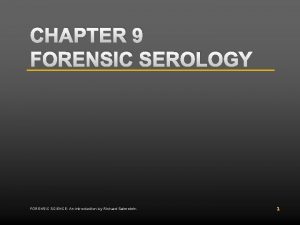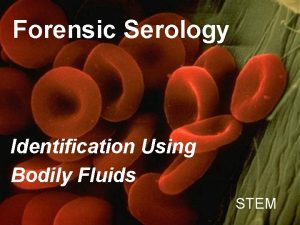Forensic Serology GAVS 11 SFS 3 Students will



































































- Slides: 67

Forensic Serology GAVS 11

SFS 3 Students will analyze the use of toxicology, serology, and DNA technology in forensic investigations. d. Differentiate the forensic techniques used to distinguish human and animal blood e. Analyze the physics of blood stain patterns. f. Compare short tandem repeat patterns (STR) and relate to identifying the DNA of an individual. g. Explain the use of the DNA database for DNA profiling. SFS 5 Students will evaluate the role of Forensics as it pertains to Medicolegal Death Investigation. a. Identify various causes of death (blunt force trauma, heart attack, bleeding, etc. ). b. Analyze evidence that pertains to the manner of death (natural, homicide, suicide, accidental, or undetermined).

Learning Targets: I can �Describe ways serological evidence helps solve a crime. �Identify the type of information can be determined from a drop of blood. �Describe how is blood typing done. �Decipher the information we get from blood stain patterns. �Describe how is blood analyzed in the Forensic lab. �Demonstrate how paternity is established through blood testing.

Serology �The medical science dealing with serums found in blood, semen, saliva, sweat, or fecal matter. �We will primarily focus on blood serum. �Blood serum is the yellow fluid (plasma) that separates from the solid components when whole blood is centrifuged.

Types of evidence obtained from serological examinations 1. Blood type and other identifying characteristics 2. 3. 4. 5. 6. in of the blood sample. Toxins, drugs, or other substances within the blood. Possible identification of disease processes that may be visible in the blood. Bloodstain pattern analysis. DNA Profile Expert testimony evidence pieces

Why Serology Evidence is important in Forensics 1. It can provide a link from victim to suspect. 2. Bloodstain patterns can provide a wealth of information about the crime, such as where it took place, how it progressed and even clues to the weapons used. 3. Serology evidence can help support a suspect’s statement leading to exoneration or it can contradict what the suspect may have stated implying some possibility of involvement in the crime. 4. Serology evidence can also differentiate between human evidence and other animal evidence that may also be found at a crime

Structure and Function of Blood � Primary function of blood is to transport gases such as oxygen and carbon dioxide, distribute nutrients such as glucose, and provide defenses for the body such as platelets for blood clotting and anti-bodies to fight bacteria, viruses, and foreign substances. � Red blood cells – erythrocytes – carry oxygen from the lungs to your body’s tissues and take CO 2 back to your lungs to be exhaled. �Surfaces have antigens that stimulate the immune system � Antibodies are various proteins produced in response to the presence of an antigen. Antibodies fight off intruder cells, such as bacteria or viruses. � White blood cells – leukocytes – travel throughout the body and destroy bacteria, some produce antibodies against bacteria and viruses, and other help fight


Structure and Function of Blood (cont) �Platelets – thrombocytes – small, colorless fragments in the blood whose main function is to interact with clotting proteins to stop or prevent bleeding. �Plasma is the liquid portion of blood composed of 92% water, 7% vital proteins such as albumin, gamma globulin, antihemophilic factor, and 1% mineral salts, sugars, fats, hormones, and vitamins. Plasma ensures blood moves effectively through the circulatory system.

Blood Types �Blood is classified into 8 basic blood types based on antigens and antibodies in the blood. First classified by the ABO group and then by the Rh Factor, creating A+, A-, B+, B-, AB+, AB-, O+, O-.

Blood Types �Antibodies produced by the A blood group remove any RBCs containing B antigens by clumping them together. (Vice versa for B blood group. ) Blood type O will not clot at all since it contains no antigens for the A or B antibodies. �The Rh factor causes clotting in those Rh positive. �Blood type is very important in blood transfusions. �Blood type is class evidence because everyone essentially has one of the 8 blood types. �DNA is considered individual evidence

DNA �Deoxyribonucleic acid (DNA) makes up genes which make up chromosomes. �Each person inherits 2 sets of genes (one from each parent). �Different forms of genes are called alleles. �The pair of alleles inherited are the person's genotype. �The phenotype is the observable characteristic of the person. �There are 3 alleles for blood: A, B, and O. �A and B are dominant over O. �Blood genotype would include both alleles. Example: AO

DNA �DNA is a large molecule made by links of a series of repeating units called nucleotides. �A nucleotide is composed of a sugar, a phosphorus-containing group, and a nitrogen-containing base.

DNA �Four types of bases are associated with the DNA structure: • • • ØAdenine (A) ØGuanine (G) ØCytosine (C) ØThymine (T) Bases pair adenine to thymine and guanine to cytosine. The bases are aligned in a double-helix configuration. The order of the bases is what distinguishes different

DNA �DNA Replication �DNA copies itself prior to cell division �DNA replication begins with the unwinding of the DNA strands of the double helix

DNA Typing �Portions of the DNA molecule contain sequences of bases that are repeated numerous times, known as tandem repeats �These tandem repeats offer a means of distinguishing one individual from another through DNA typing. �Length differences associated with repeating DNA strands are called restriction fragment length polymorphisms (RFLP) and form the basis for DNA typing. �Restriction enzymes “cut” the DNA into pieces based on these repeating segments.

DNA Typing • Electrophoresis forces separated pieces of DNA across a gel-coated plate under the influence of an electrical potential. • Smaller DNA fragments move at a faster rate than the larger ones • When comparing the DNA fragment patterns of two or more specimens, one merely looks for a match between the band sets.

PCR Testing �DNA is heated to separate it �Primers (short strands of DNA used to target specific regions of DNA for replication) are added, which hybridize with the strands �DNA polymerase and free nucleotides are added to rebuild each of the separated strands �Best used when the sample is small.

Mitochondrial DNA Testing �m. DNA is located in the mitochondria of cells. �m. DNA is inherited strictly from the mother. �m. DNA analysis is more rigorous, time consuming, and costly when compared to nuclear DNA analysis

CODIS �Combined DNA Index System �Computer software developed by the FBI that maintains local, state, and national databases of DNA profiles from convicted offenders, unsolved crime scene evidence, and profiles of missing person. �Currently contains about 470, 000 profiles from unsolved cases.

Collection of DNA Evidence �Blood �Semen �Saliva �Skin cells �Hair �Bone

Collection of DNA Evidence �Clothing from victim and suspect with blood evidence must be collected �Dried blood is best removed from a surface using a sterile cotton swab lightly moistened with distilled water that is air dried before placed in a swab box, and then in a paper or manila envelope. �Standard/reference DNA specimens must also be collected with a buccal swab (swab of the cheek). �Packaging of biological evidence in plastic or airtight containers must be avoided because the accumulation of residual moisture could contribute to the grown of DNA-destroying bacteria and fungi.

Other Serological Evidence �Semen, or seminal fluid, is produced by the male reproductive organs. �If spermatozoa are present, DNA testing can be done. �Spermatozoa may not be present if the perpetrator has a low sperm count or has had a vasectomy. �Saliva can be determined by testing for an enzyme called amylase. Amylase breaks down starch to begin digestion. �Saliva can be tested to determine the presence of trace amounts of drugs in a body.

Immunoassay Techniques �When a stain is encountered at a crime scene that appears to be blood, there are several questions: 1. Is it blood? 2. If it is blood, is it human or some other species? 3. If it is human, can it be linked to a particular individual? � Is it blood? � Screening test for blood – spray area with Luminol. � Luminol reacts with iron from the hemoglobin of blood causing a faint blue fluorescence. � Works on even tiny amounts of blood � Works on diluted samples of blood (up to 300, 000 times dilute) � Does not interfere with subsequent DNA analysis that may be done � May destroy other components for testing.

Immunoassay Techniques Luminol

Immunoassay Techniques (cont) � Is it blood? (cont) �Kastle-Meyer Color Test – uses a solution of pheolphthalein and hydrogen peroxide on a piece of filter paper to detect blood. � Paper turns pink when exposed to blood � If it is blood, is it human? �Precipitin test will distinguish human blood from blood of other species. �Precipitin is an antibody that reacts with its corresponding antigen in human blood. �If the blood sample clots, then the blood must be human. �Once determined to be human, DNA evidence may be able to link the blood to a specific individual. �Blood can also be tested for the presence of drugs or alcohol.

CASE STUDY: Lindy Chamberlain �http: //lindychamberlain. com/legal-process-and- findings/forensic/

Blood Stain Patterns �Using concepts from Biology and Physics, investigators are able to discern a lot about a crime scene just by observing any blood that is present. �Patterns of drops, pools, or smears of blood provide crucial information about the sequence of the crime as well as the weapon used and possible identifying information about the perpetrator. �For example, blood spatterns can reveal the origin of the attack, distance from the target, direction of the force, position of the persons involved, movement of persons involved, and number of blows or shots. Blood spatter can be

Crime Scene Reconstruction �Recovery of physical evidence can be used to sort out the events surrounding the crime. �Example: A laser is used to determine the search area for the position of a shooter who fired a bullet through a window and wounded a victim.

Bloodstain Features �Bloodstain pattern interpretation may uncover; �The direction from which the blood originated �The angle at which a blood droplet struck a surface �The location or position of a victim at the time a bloody wound was inflicted. �The movement of a bleeding individual at the crime scene �The approximate number of blows that struck a bleeding victim �The approximate location of an individual delivering blows that produced a bloodstain pattern.

Bloodstains Surface texture is of paramount importance. In general, the harder and less porous the surface, the less spatter results. Bloodstain from a single drop that struck a glass surface after falling 24 inches Bloodstain from a single drop that struck a cotton muslin sheet after falling 24 inches

Directionality and Angle of Impact � The angle of impacts of blood on a flat surface can be determined by measuring the degree of circular distortion. � At right angles, the blood is circular; as the angle decreases, the stain becomes elongated. � The higher pattern is of a single drop of human blood that fell 24 inches and struck hard, smooth cardboard at 50◦. � The lower pattern is of a single drop of human blood that feel 24 inches and struck hard, smooth cardboard at 15◦. The tail shows the direction

Directionality and Angle of Impact �Mathematically, the angle of impact can be calculated by the equation and determining the inverse of Sine A: Sin A = Width of Blood Stain Length of Blood Stain �The impact angle of blood on a flat surface can be determined by measuring the degree of circular distortion. �At right angles, the blood drop is circular; as the angle decreases, the stain becomes elongated.

Angle of Impact (cont) �Calculating angle of impact: ratio between the length and the width of a blood drop is the function of the sine of the angle of impact. sin (α) = w / l sin (α) is the angle of impact w is the width of the bloodstain l is the length of the bloodstain.

Angle of Impact �By connecting a line of string from the point of origin to the blood spatter, an investigator can use a protractor to determine the angle of impact. �The angle of impact can be estimated reproducing spatterns at various angles and observing the outcome. �When a drop of blood falls, it forms a spherical shape. When it hits a surface, the drop leaves a bloodstain of varying elliptical degrees that can indicate the angle of impact.

Angle of Impact (cont) � Calculating angle of impact: Examples � Let us say that the width is 9 mm and the length is 18 mm. STEP 1: sin-1(9 mm/18 mm) = 30 The angle of impact was 30 . � Let us say that the width is 1. 5 cm and the length is 3. 0 cm. STEP 1: sin-1(1. 5 cm/3. 0 cm) = 30 The angle of impact was 30 . � When calculating the angle of impact it is important to keep in mind that (sin-1) does not mean (1/sin). Instead, it means the inverse sin function. When dividing we make sure to divide the smaller number by the larger number to get a number less than one.

Point of Convergence and Point of Origin �Point of convergence – starting point of the bloodshed event. �Determined by creating intersecting lines through blood drops to identify where all the lines intersect. �Shows the origin and direction from which the blood was traveling. �Point of origin – where the suspect and victim were and possibly how they were positioned during the bloodshed event. �Adds a third dimension to the scene. �Determined using protractors and elastic strings to show the angle and direction in which the blood traveled across the crime scene. �Intersection of the strings helps determine the location of the persons and angle of impact

Point of Convergence and Point of Origin (cont)

Area of Convergence �The area of convergence is the point on a two- dimensional plane from which the drops in an impact pattern originated. �This can be established by drawing straight lines through the long axis of several individual bloodstains, following the line of their tails.

Area of Origin �The area of origin of an impact bloodstain pattern is the area in a three-dimensional space from which the blood was projected. �This will show the position of the victim or suspect in space when the stain-producing even took place. �The string method is commonly used at a crime scene to approximate the position of the area of origin using found angles of impact of individual stains in the pattern.

Blood Pattern Analysis

Impact Bloodstain Spatter Patterns �Impact spatter occurs when an object impacts a source of blood. �Forward spatter is projected outward and away from the source �Back spatter, also known as blow-back spatter, is projects backward from the source. �The direction of travel of blood striking an object may be discerned because the pointed end of a bloodstain always faces its direction of travel

Classifying Impact Spatter � Using droplet size to classify impact patterns by velocity gives investigators insights into the general nature of a crime but cannot illuminate the specific events that produced the spattern. � Low Velocity Spatter �Drops with diameters of 4 mm or more normally produced by an applied force of up to 5 ft/sec. � Medium Velocity Spatter �Drops with diameters of 1 -4 mm with an applied force of 5 to 25 ft/sec � High Velocity Spatter �Drops with diameters of less than 1 mm from an applied force of 100 ft/sec or faster.

Sources of Blood Spatter �Impact Spatter �Cast-off Spatter �Arterial Spray Spatter

Gunshot Spatter �Gunshot spatter is fine forward spatter from an exit wound and back spatter from an entrance wound. �The gunshot produces only back spatter if the bullet does not exit the body. �Depending upon the distance from the victim that the gun was discharged, some back spatter may strike the gunman and enter the gun muzzle. This is call the drawback effect.

Cast-off Spatter �A cast off pattern is created when a blood- covered object flings blood in an arc onto a nearby surface. �This kind of pattern is commonly produced by a bloody fist or weapon between delivering blows. �The features of the cast off pattern are affected by the size of the object, the amount of blood, and the direction the object was moving. �By counting and pairing forward/backward patterns, one may determine the minimum number of blows delivered.

Arterial Spray Spatter � Arterial spray spatter is caused by an injury to the heart or a main artery and the pressure of the continued pumping. � The site of the initial injury to the artery can be found where the pattern begins with the biggest spurt. � The trail away from this points shows the victim’s movement. � The oxygenated blood spurting from the artery tends to be a brighter red color than blood expelled from impact wounds.

Expirated Blood Patterns �An expirated blood pattern is created by blood that is expelled from the mouth or nose from an internal injury. �The presence of bubbles or oxygen in the drying drops, or a lighter color as a result of dilution by saliva, can differentiate a pattern created by expiration blood. �The presence of expirated blood gives an important clue as to the injuries suffered and the events that took place at a crime scene.

Void Patterns �A void is created when an object blocks the deposition of blood spatter onto a target surface or object, and the spatter is deposited onto the object or person instead. �The blank space on the surface or object may give a clue as to the size an shape of the missing object or person. �Voids may be applicable for establishing the body position of the victim or assailant at the time of the incident.

Contact/Transfer Patterns �A contact or transfer pattern is created when an object with blood on it touches one that does not have blood on it. �Simple transfer patterns are produced when the object makes contact with the surface and is removed without any movement of the object. �The size and general shape of the object may be seen in a simple transfer �Other transfers, known as swipe patterns, may be caused by movement of the bloody object across a surface.

Flows �Flow patterns are made by drops or large amounts of blood flowing by the pull of gravity. �The glow direction may show movements of objects or bodies while the flow was still in progress or after the blood dried. �Interruption of a flow pattern may indicate the sequence and passage of time between the flow and its interruption.

Pools �A pool of blood occurs when blood collects in a level (not sloped) and undisturbed place. �Blood that pools on an absorbent surface may be absorbed throughout the surface and diffuse, creating a pattern larger than the original pool. �Considering the drying time of a blood pool can yield information about he timing of events that accompanied the incident.

Skeletonization �The phenomenon of skeletonization occurs when the edges of a stain dry to the surface. �This usually occurs within 50 seconds of deposition of droplets, and longer for larger volumes of blood. �After this time, if the bloodstain is altered through contact of a wiping motion, the skeletonized perimeter will be left intact. �Knowing the skeletonization time, an investigator determines the timing of movement or activity.

Drop Tail Patterns �The pattern may show direction and speed of movement, lead to a discarded weapon, or provide identification of the suspect by his or her own blood.

Bloodstain Pattern Analysis �See handout �Use pdf version to access links.

Documenting Bloodstain Evidence �Investigators should note, study, and photograph each pattern and drop to record the location of specific patterns accurately and to distinguish the stains from which laboratory samples were taken. �Grid Method – a grid of squares of known dimensions are set up over the entire pattern. �Perimeter Ruler Method – a rectangular border of rulers is set up around each pattern and a smaller ruler is placed next to each stain.

More info on Bloodstain Patterns �http: //www. slideshare. net/lexakay/bloodstain- pattern-recognition �http: //science. howstuffworks. com/bloodstainpattern-analysis. htm �http: //www. crime-scene-investigator. net/simplified -guide-to-bloodstain-pattern-analysis. html

Forensic Serology Review What blood types are possible from these parents: 1. Mom – AB Dad – AB 2. Mom – AB Dad – O 3. Mom – B Dad – B 4. Mom – A Dad - O

Forensic Serology Review Answer What blood types are possible from these parents: 1. Mom – AB Dad – AB AB, A, B 2. Mom – AB Dad – O A, B 3. Mom – B Dad – B B, O 4. Mom – A Dad – O A, O

Forensic Serology Review �Match the definitions to the correct term Definition term The science that deals with the properties and reactions of serums, especially blood serum. Genes A substance that stimulates the immune system to manufacture antibodies (immunoglobulins). Alleles Any of various proteins produced in the blood in response to the presence of an antigen. Antigens A hereditary unit consisting of a sequence of DNA that occupies a specific location on a chromosome and determines a particular characteristic in an organism. Serology One of two or more alternative forms of a gene at the same site in a chromosome, which determine alternative characters in inheritance. Antibodies

Forensic Serology Review Answers �Match the definitions to the correct term Definition term The science that deals with the properties and reactions of serums, especially blood serum. Serology A substance that stimulates the immune system to manufacture antibodies (immunoglobulins). Antigens Any of various proteins produced in the blood in response to the presence of an antigen. Antibodies A hereditary unit consisting of a sequence of DNA that occupies a specific location on a chromosome and determines a particular characteristic in an organism. Gene One of two or more alternative forms of a gene at the same site in a chromosome, which determine alternative characters in inheritance. Alleles

Forensic Serology Review �Match the definitions to the correct term Definition term An organism’s genetic makeup Presumptive Testing The observable physical or biochemical characteristics of Genotype an organism, as determined by both genetic makeup and environmental influences. Also known as preliminary tests, screening tests or field tests Kastle-Meyer Color Test A presumptive test used to detect if a substance is blood. Phenotype It works using phenolphthalein which turns pink in the presence of blood. An antibody in blood that combines with an antigen to form a solid that separates from the rest of the blood. Precipitin

Forensic Serology Review Answers �Match the definitions to the correct term Definition term An organism’s genetic makeup Genotype The observable physical or biochemical characteristics of Phenotype an organism, as determined by both genetic makeup and environmental influences. Also known as preliminary tests, screening tests or field tests Presumptive Testing A presumptive test used to detect if a substance is blood. Kastle-Meyer It works using phenolphthalein which turns pink in the Color Test presence of blood. An antibody in blood that combines with an antigen to form a solid that separates from the rest of the blood. Precipitin

Forensic Serology Review �Match the definitions to the correct term Definition term A component of blood which is one of the body’s defenses against disease. This where DNA is gathered from blood samples. Plasma The liquid part of blood that is 92% water. Luminol Conclusively identifies the identity of a biological material Confirmatory Testing This compound gives a strong blue fluorescence when viewed with a UV light in the presence of blood or blood residue even when very diluted. Agglutination The clumping together of red blood cells or bacteria, usually in response to a particular antibody White Blood Cells

Forensic Serology Review Answers �Match the definitions to the correct term Definition term A component of blood which is one of the body’s defenses against disease. This where DNA is gathered from blood samples. White Blood Cells The liquid part of blood that is 92% water. Plasma Conclusively identifies the identity of a biological material Confirmatory Testing This compound gives a strong blue fluorescence when viewed with a UV light in the presence of blood or blood residue even when very diluted. Luminol The clumping together of red blood cells or bacteria, usually in response to a particular antibody Agglutination

Forensic Serology Review �Match the definitions to the correct term Definition term An enzyme that breaks down starch and helps the body begin to break down food which can be tested for and used to determine if a sample is saliva. Expirated Blood This bloodstain occurs when blood is transferred from a bloody object to a previously unstained surface Wipe Occurs when a bloodstain is removed or altered because Swipe a non-bloody object has moved through a wet blood stain. A blood pattern in which a weapon or object swings in an Cast-off arc and deposits blood on a surface in the path of that arc. Blood that exits the body after an internal injury through the nose or mouth in the process of breathing or coughing. Amylase

Forensic Serology Review Answers �Match the definitions to the correct term Definition term An enzyme that breaks down starch and helps the body begin to break down food which can be tested for and used to determine if a sample is saliva. Amylase This bloodstain occurs when blood is transferred from a bloody object to a previously unstained surface Swipe Occurs when a bloodstain is removed or altered because Wipe a non-bloody object has moved through a wet blood stain. A blood pattern in which a weapon or object swings in an Cast-off arc and deposits blood on a surface in the path of that arc. Blood that exits the body after an internal injury through the nose or mouth in the process of breathing or coughing. Expirated Blood
 Father of forensic serology
Father of forensic serology Leone lattes contribution to forensic science
Leone lattes contribution to forensic science Define forensic serology
Define forensic serology Arterial spray definition forensics
Arterial spray definition forensics Father of forensic serology
Father of forensic serology Father of forensic serology
Father of forensic serology Hemastix definition
Hemastix definition Importance of forensic serology
Importance of forensic serology Gavs meaning
Gavs meaning Forensic pathologist vs forensic anthropologist
Forensic pathologist vs forensic anthropologist Forensic psychiatry vs forensic psychology
Forensic psychiatry vs forensic psychology Forensic
Forensic Forensic science blood basics notes
Forensic science blood basics notes Serology
Serology Serology book
Serology book Prometheus celiac serology
Prometheus celiac serology Proteus non lactose fermenter
Proteus non lactose fermenter Serology
Serology Serology
Serology Sfs2213
Sfs2213 Jännitetyö lähialue
Jännitetyö lähialue Sfs significado
Sfs significado Promissory note uwaterloo
Promissory note uwaterloo Finnish standards association
Finnish standards association Jon dietrick babson
Jon dietrick babson Seguro familiar de salud
Seguro familiar de salud Sfs 2010:659
Sfs 2010:659 25
25 Rita flödesschema
Rita flödesschema Pien- ja pienoisjännite sähköasennukset
Pien- ja pienoisjännite sähköasennukset Teräslaadut taulukko
Teräslaadut taulukko Hitsausmerkinnät
Hitsausmerkinnät Sfs-en iso 5817
Sfs-en iso 5817 Sfs car rental
Sfs car rental Specsfs
Specsfs Pasi hongisto
Pasi hongisto Cui sfs
Cui sfs What image did rizal carved on a piece of batikuling
What image did rizal carved on a piece of batikuling Computer forensic lab
Computer forensic lab Forensic geologist definition
Forensic geologist definition National association of forensic social workers
National association of forensic social workers Forensic recovery of evidence device
Forensic recovery of evidence device Veronica scotti
Veronica scotti Chapter 13 forensic anthropology
Chapter 13 forensic anthropology Forensic science chapter 1
Forensic science chapter 1 Definition of forensic toxicology
Definition of forensic toxicology Functions of a forensic scientist
Functions of a forensic scientist Forensic psychology
Forensic psychology Projected pattern blood
Projected pattern blood Department of forensic science dc
Department of forensic science dc Forensic math
Forensic math Forensic analysis of paper
Forensic analysis of paper Mass spectrometry in forensic science
Mass spectrometry in forensic science Forensic word derived from
Forensic word derived from Chapter 14 review forensic science
Chapter 14 review forensic science Serial killers forensic psychology
Serial killers forensic psychology Forensic psychology serial killers
Forensic psychology serial killers Anatomy of a maggot
Anatomy of a maggot Falcon forensic collector
Falcon forensic collector Types of ballistics
Types of ballistics Edmond locard forensic science
Edmond locard forensic science Ted bundy odontology
Ted bundy odontology Acts in pharmaceutical jurisprudence
Acts in pharmaceutical jurisprudence Forensic taxonomy
Forensic taxonomy Forensic
Forensic Ted bundy teeth
Ted bundy teeth Forensic science microscopes
Forensic science microscopes Digital photography in forensic science
Digital photography in forensic science


